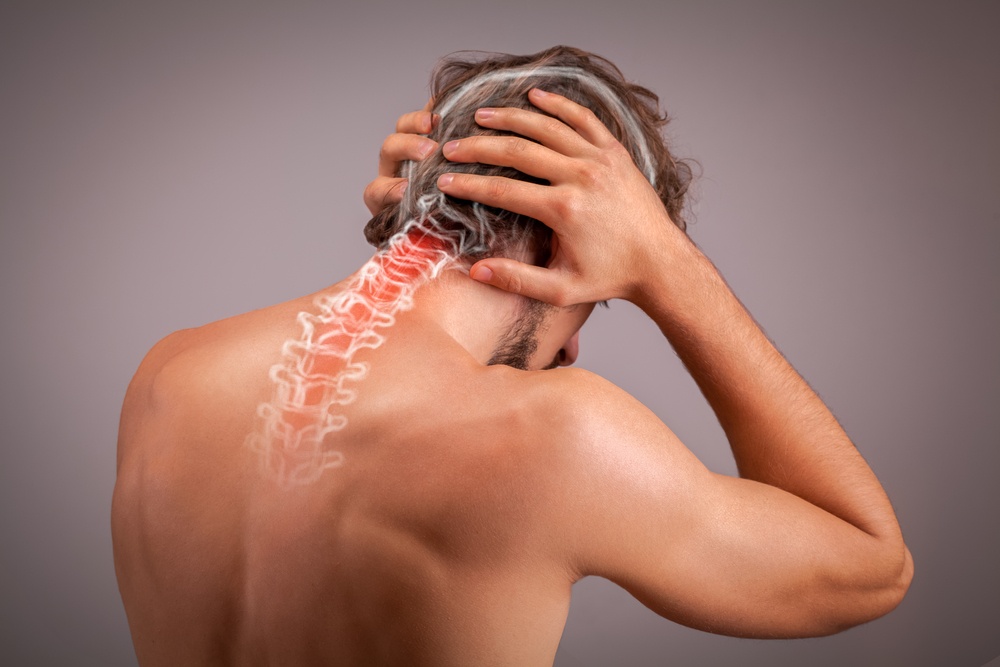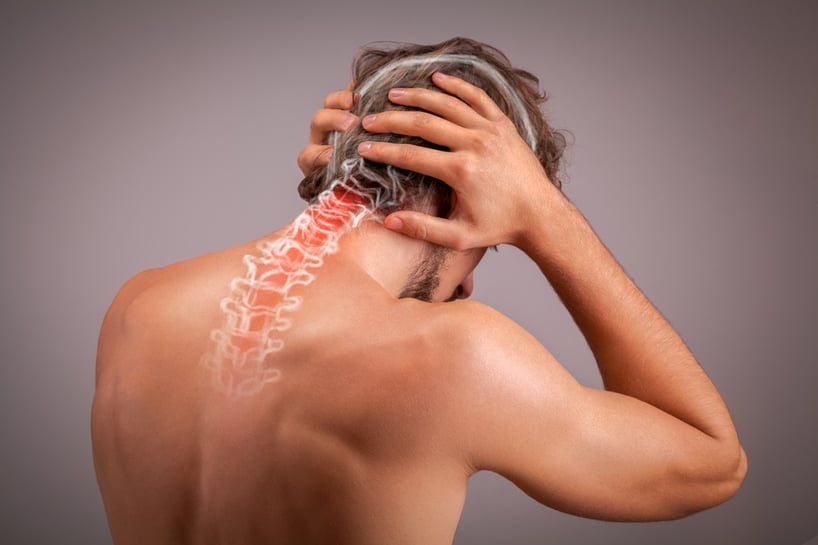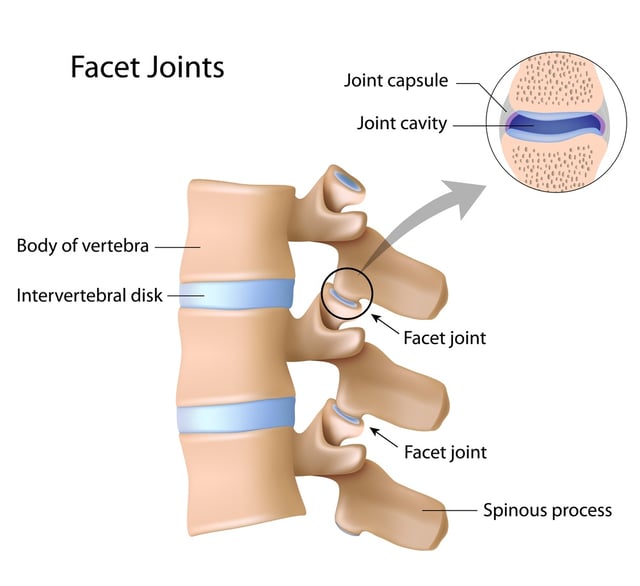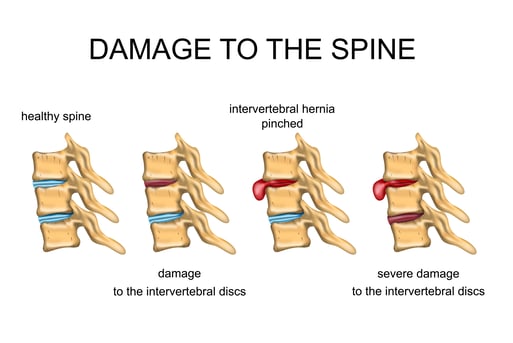Chronic Neck Pain: Treatment Options
January 19th, 2017 | 7 min. read


The human neck is an excellent buffer against head injuries. Its flexibility allows the head to move with any minor impact to any body part, protecting the brain from smashing into the hard inner wall of the skull, which results in concussions. Even the effects of major impacts, such as whiplash injuries that are common in rear-end automobile collisions, can be lessened by the shock absorbing design of the neck.
This protection does come at a price: neck pain. In protecting the brain, the neck may be yanked in any direction, pushed into an awkward position, or snapped hard enough to overextend its normal stretching limits.
The most typical neck injuries that cause pain are strains of the neck’s muscles and tendons, and sprains of the ligaments connecting the seven vertebrae that comprise the cervical spine (aka the neck).
Generally, these result in the following annoying but short-term pains in the neck:
- Difficulty moving or turning the head
- Sharp, stabbing pain in one small, specific location
- Soreness or tenderness (dull pain) in a general location
- Radiating pain that extends from the neck down to the shoulder, arm, or fingers
As bad as these injuries may sound, they represent relatively minor damage that may often be treated effectively with home remedies: cold, heat, rest, and over-the-counter pain relievers. Most minor neck pain dissipates after just a few days or a few weeks.
Definition: What is Chronic or Long-Term Neck Pain?
Simple neck pain may be caused by sports injuries, poor posture, holding your head in an unnatural or abnormal position for an extended period of time, repetitive motion, or just by sleeping with your head half-on and half-off of your pillow at night. These minor strains and sprains will go away relatively quickly.
In contrast, chronic neck pain is a condition in which neck pain lasts longer than three months. If this long-term neck pain is accompanied with other symptoms such as weakness, numbness, and difficulty walking, it may indicate a far more serious underlying condition.
Common Causes of Chronic Neck Pains
Injuries, overuse, and aging (simple “wear and tear”) are the most common causes of long-term neck pain. Specific conditions that may result in chronic neck discomfort include:
- Damage to, or abnormal structures within, the neck bones (cervical vertebrae)
- Damage to the facet joints between pairs of vertebrae
- Damage to the discs layered between each cervical vertebra
- Poor posture
- Degenerative Diseases (including aging and arthritis)
Less common causes of long-lasting pains in the neck include tumors, severe muscle strains, and severe damage to the ligaments connecting the bones to each other. Fractures and cracks to the bones of the neck may also cause chronic neck pain, especially if the bones are not set properly or heal incorrectly.
The Anatomy of the Neck
The neck is part of the spine, a stacked, interconnected column of 33 roughly disc-shaped bones (vertebra) that provides the body’s fundamental structural component.
- The neck comprises the spine’s first seven vertebrae, together making up a section called the cervical spine. The topmost vertebra, called C-1, connects directly to the base of the skull and uniquely allows for head rotation.
- In between each vertebra lies a disc of connective tissue, filled with a jelly-like substance called nucleus pulposus. Discs provide cushioning and spacing, as well as helping to ensure the spine is aligned properly.
- Nearly every pair of vertebrae are connected by a pair of tiny facet joints, very similar to those found in knees, shoulders, and fingers, and located deep inside the spine.
- Each vertebra features has several holes (neural foramina) through which the spinal cord and spinal nerve roots thread their way en route to the rest of the body.
The cervical spine’s bones serve as anchors for all of the soft tissues of the neck, including the muscles, tendons, and ligaments that allow for its mobility and flexibility.
Collectively, all these intra-neck structures support the heavy, awkward ball of the human head, which typically weighs in at approximately eleven pounds.
Types of Neck Pain
People suffering from chronic neck pain may encounter any or all of the minor pains listed above, as well as other far more alarming health conditions, such as:
- tingling and numbness that stretches like a radiating pain
- difficulty lifting, gripping, and holding objects
- problems with coordination, walking, and overall balance
- loss of control over one’s bladder or bowels
The most common causes The two most common areas causing chronic neck pain are the facet joints and the discs.
Facet Joints
 The facet joints are located deep inside the spine, and is structured just like all the other synovial joints throughout the body: two rounded bone ends covered with a thin layer of cartilage, enclosed by a fibrous joint capsule filled with synovial fluid.
The facet joints are located deep inside the spine, and is structured just like all the other synovial joints throughout the body: two rounded bone ends covered with a thin layer of cartilage, enclosed by a fibrous joint capsule filled with synovial fluid.
- These facet joints can become damaged in a whiplash injury, in which the head snaps hard forward, rebounds from the chest, and snaps equally hard backwards. As a result, the joint capsule may tear, causing it to leak its synovial fluid, or the cartilage itself may rip, allowing the connected vertebrae to grind together.
- Cervical Osteoarthritis/Spondylosis (aka Neck Arthritis) may result when the cartilage within the facet joints wears down through normal use, or tears through some injury. The resulting grinding between the bones of the vertebrae may cause inflammation, bone spurs, and nerve pinching as the tiny spaces within the vertebrae for neural passages become squeezed shut.
Discs
- The discs lie between every vertebra and serve as cushions among the bones of the spine. As they are made completely
 of soft, tough tissues, they are remarkably elastic and flexible – but may tear due to injury, overuse, and aging.
of soft, tough tissues, they are remarkably elastic and flexible – but may tear due to injury, overuse, and aging.
- Pain may arise from the disc itself if it develops a tear in its center, where the the nucleus pulposus jelly normally lies. Should that jelly leak into the outer periphery of the disk, it will cause inflammation and irritation to the nerves that are located in that area.
- A herniated disc is also a torn or otherwise damaged disc, but the leaking nucleus pulposus jelly may cause swelling or distortion of the disc. This results in the disc pressing against the cervical nerves passing through their designated holes through the vertebra – also known as “pinched nerves.”
- Cervical Degenerative Disc Disease may occur as over a normal lifetime, the discs naturally lose hydration, thickness, and cushioning abilities. When it degenerates too far, a degenerated disc may case the same problems as a herniated disc, including pinched nerves and arthritis.
Treatments of Chronic Neck Pain
Home remedies may often serve as the best means of managing chronic neck pain. If the pain persists for three months or more, more aggressive treatments may be required.
Rest. Just like a sprained ankle or strained calf will benefit from “taking it easy,” an injured neck will benefit from rest. That does not mean you have to sleep 16 hours a day, though: simply find a comfortable position in a chair, couch, or bed, that gives you the least amount of neck pain, and stay there for a while. Sometimes placing a rolled towel beneath your neck will help by keeping your head and neck in a “neutral” or straight position.
Pain relievers. Taking over-the counter medication is an effective means of managing chronic neck pain. Non-steroidal anti inflammatory medications (NSAIDS) such as ibuprofen (brand names Advil or Motrin) and naproxen (Aleve, Naprosyn) are good options. Some people may respond better to pain relievers like acetaminophen (Tylenol) and the old standby, aspirin: it all depends on what works best for you.
Applying cold and heat. For strains and sprains, ice is recommended for the first 1-2 days to reduce swelling. Afterwards, heat wraps should be used to keep the muscles loose and relaxed. But if you are suffering from damage to your cervical discs, bones, or facet joints, neither treatment will be particularly effective, and should be used only if it makes you feel more comfortable.
Improving posture. This is a major factor in neck pain, both simple and chronic. Very simply, keep your head and neck straight and upright, and be sure to support your back properly. That translates into:
- sitting up correctly in your chairs (just like your dear old grandma tried to drill into you!)
- avoiding any slouched or slumped position while on your sofa
- avoiding any backless seating, such as bar stools or piano benches.
In this digital era, good posture also means:
- putting your computer at eye level
- not leaning forward or backward in your chair
- keeping your keyboard and mouse where you aren’t stretching for them, but have them readily within reach of your arms (which should be typing at a 90-degree angle from your body)
Physical Therapy and Exercise. Before doing any stretching or flexibility exercises to ease your long-term neck pain, be sure to check with your doctor to ensure you will not do any further damage to your cervical spine.
 Studies have shown that doing strength and endurance exercises with light weights or light resistance bands can significantly improve chronic neck pain. Under the direction of a certified physical therapist, maintaining a consistent activity level, stretching regimen, and strengthening routine for your neck and spine can improve overall blood flow to the spine, keeping it healthy and assisting your body’s continuous efforts to heal itself.
Studies have shown that doing strength and endurance exercises with light weights or light resistance bands can significantly improve chronic neck pain. Under the direction of a certified physical therapist, maintaining a consistent activity level, stretching regimen, and strengthening routine for your neck and spine can improve overall blood flow to the spine, keeping it healthy and assisting your body’s continuous efforts to heal itself.
In some cases, a technique called neck traction may be used to gently pull the head away from the body. This relieves pressure on the discs, literally lifting them off of any nerves that a torn or ruptured disc may be placing upon spinal nerves.
Surgery. When more conservative treatments have not helped alleviate chronic neck pain after eight weeks, or if you suffer from pain, weakness, or numbness in your shoulders, arms, or hands, it may be time to consider surgery. Depending on the diagnosis and your age, several surgical options are available:
- Anterior Cervical Discectomy and Fusion (ACDF). In this most common of neck surgeries, the entire damaged disc is removed through the front, or anterior, or the neck. The two vertebrae are then surgically fused to ensure the spine remains stable afterwards.
- Posterior Cervical Decompression/Microdiscectomy. When only part of a disc requires removal and no spinal fusion is required, it is possible to perform the surgery through the back, or posterior, of the neck. This is only recommended if the damaged portion of the disc lies too close to the spinal cord, which runs through the back of the neck.
- Disc Replacement. Artificial discs are now available to fully replace a damaged disc. While the procedure is relatively new and there are yet no long-term studies available, cervical artificial disc replacement promises to retain more flexibility and motion in the neck over ACDF or PCD procedures.
- Posterior Cervical Foraminotomy. If the gap through with the spinal column passes (the foramen) becomes narrowed, either via a herniated disc or development of a bone spur, it may be possible for a surgeon to go through the back of the neck to remove part of the affected disc, or break off the abnormal bit of bone. This procedure puts the spinal cord at some risk, but avoids the need to perform any spinal fusion.
- Spinal Decompression. In some cases where the spinal cord itself is being compressed by bone spurs or swelling (a condition known as spinal stenosis), there is the option of removing parts of, or the entire vertebra, to relieve the problem.
- Anterior Cervical Corpectomy surgery removes at least one vertebral body (the bone at the front of a vertebra) plus the discs immediate above and below the affected vertebra bone. The bones will then be fused into one solid segment, using either a bone graft or installation of a cage.
- Posterior Cervical Laminectomy surgery takes out a back part of a vertebra, called the lamina. This procedure potentially allows you to keep more of your normal neck flexibility, unless a spinal fusion procedure is also required.
- Posterior Cervical Laminoplasty surgery cuts an affected lamina, rather than removing it, and performing some restructuring of the bone to open up more space in the spinal canal.
Contact Coastal Orthopedics in Corpus Christi, Texas at 361.994.1166 or just click the button below to request your appointment today!
Article written by: Rob Williams, MD
Dr. Williams has been practicing orthopedic surgery in Corpus Christi since 1998. After graduating from Texas Tech hereceived his medical degree from the University of Texas at San Antonio. At the prestigious Campbell Clinic located at the University of Tennessee, Dr. Williams completed not only an Orthopedic Surgery Residency, but an additional year of Fellowship Training in Spine Surgery. Dr. Williams is dedicated to creating an excellent patient experience in the office or in the surgery suite.
Topics:


